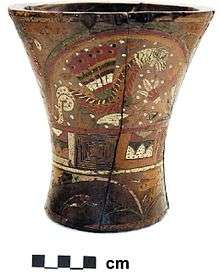Amaru (mythology)
In mythology of Andean civilizations of South America, the amaro, amaru (quechua) or katari (aymara) is a mythical serpent or dragon, most associated with the Tiwanaku and Inca empires. In Inca mythology, the amaru is a huge double-headed serpent that dwells underground, at the bottom of lakes and rivers.[1] Illustrated with the heads of a bird and a puma, amarus can be seen emerging from a central element in the center of a stepped mountain or pyramid motif in the Gateway of the Sun at Tiwanaku, Bolivia. When illustrated on religious vessels, the amaru is often seen with bird-like feet and wings,[2] so that it resembles a dragon. The amaru was believed capable of transgressing boundaries to and from the spiritual realm of the subterranean world.[2]


References
- Steele, Paul R. (2004). "Encyclopedia of Mythic Narratives, Themes, and Concepts". Handbook of Inca Mythology. Santa Barbara, Calif.: ABC-CLIO. pp. 95–98. ISBN 1576073548.
- Smith, S. (2011). "Generative landscapes: the step mountain motif in Tiwanaku iconography" (Automatic PDF download). Ancient America. 12: 1–69.